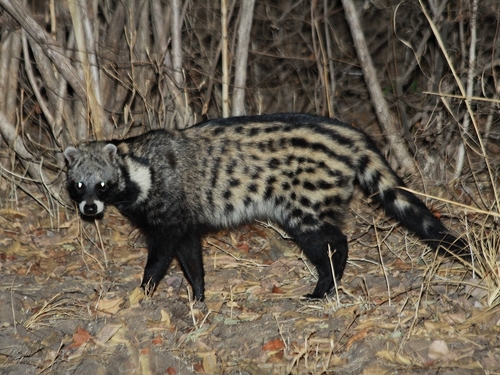
African Civet
The African civet, with its bold black-and-white coat and musky aroma, prowls sub-Saharan Africa's night. This solitary omnivore thrives in savannas and forests, contributing to ecosystems by dispersing seeds. Its unique scent and nocturnal habits make it a fascinating subject of the African wilderness.
15-20 years
Lifespan
1.4 - 4.5 kg
Weight
Height: 43 - 71 cm
Size
Brown, Grey, Yellow, Black, White, Tan
Color
11-12 months
Age of Sexual Maturity
8-10 weeks
Age of Weaning
Least Concern
Conservation Status
Unknown
Population Trend
Characteristics
The African civet (Civettictis civetta) inhabits sub-Saharan Africa's savannas and forests. Known for its striking black-and-white markings and a distinctive musky scent, it is solitary and nocturnal. It is an omnivore, feeding on small animals, fruits, and insects, playing a crucial role in seed dispersal.
Distribution Range of the African Civet
The African civet (Civettictis civetta) is native to sub-Saharan Africa. It is widely distributed across this region, from Senegal and Mauritania in the west to Sudan and Ethiopia in the east, and extending southwards to South Africa. The species is notably absent from the arid regions of the Sahara Desert and some parts of the Namib Desert.
African Civet's Habitat
Environmental Conditions
The African civet thrives in a variety of habitats but predominantly occupies savannas, forests, and woodland areas. It prefers regions with dense vegetation that offer ample cover and abundant food sources. These environments typically feature a warm climate with varied precipitation levels depending on the specific location within sub-Saharan Africa.
Ecological Niche
The African civet is a nocturnal omnivore, feeding on a diverse diet that includes small mammals, birds, insects, fruits, and other plant materials. It plays a significant role in its ecosystem as both a predator and a seed disperser, contributing to the ecological balance by controlling prey populations and aiding in plant propagation. Its adaptability to different environments allows it to thrive in both natural and human-altered landscapes.
Copyright @ Nature Style Limited. All Rights Reserved.
 English
English